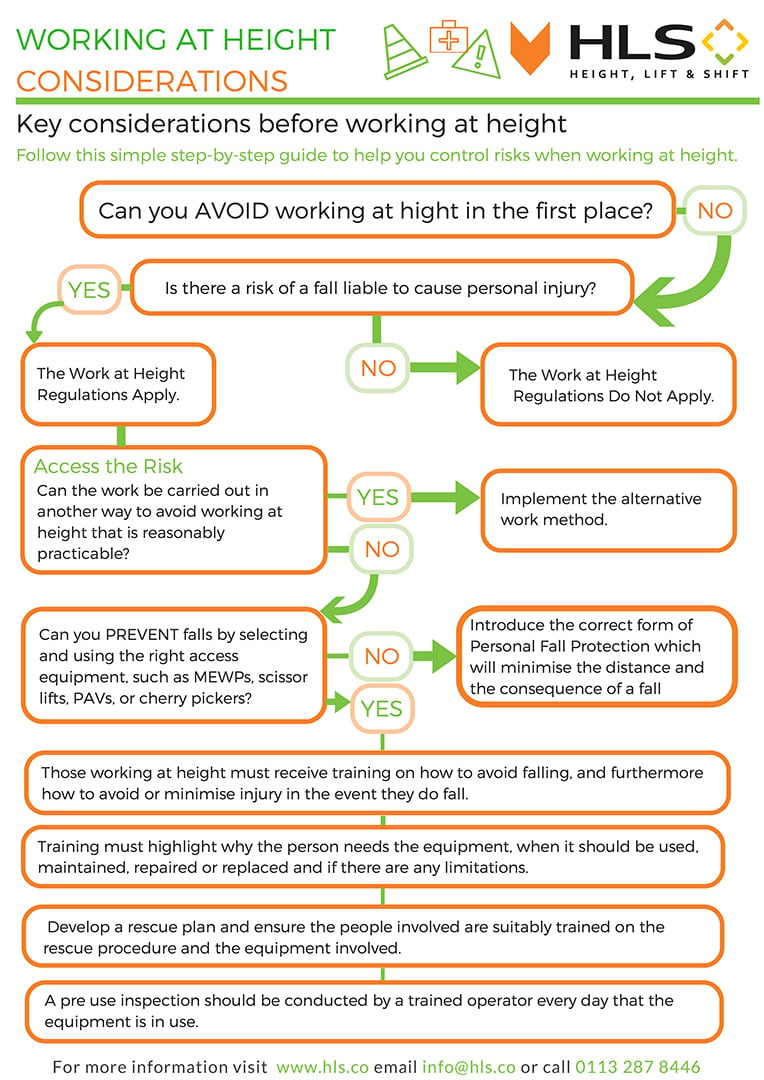Download
Download the HLS WAH Key Considerations Flowchart
This is a work at height key consideration flowchart to help you manage risks and ensure you're compliant and safe when working at height.

Health and safety laws apply to all businesses, regardless of their size or turnover, and as an employer, it is your responsibility to provide a safe working environment for your staff and undertake the right precautions to reduce the risks of workplace dangers
Follow this simple step-by-step guide to help you control the risks when working at height.
Just fill in the short form and your download will be available
Fill in the Form Below to Download Your Flowchart
Download the HLS Working at Height (WAH) Key Considerations Flowchart
Working at height remains one of the most common causes of workplace accidents, injuries, and even fatalities across many industries. Whether you are in manufacturing, maintenance, warehousing, or facilities management, the risks associated with working above ground level can be serious if not managed properly. That is why HLS has created a simple yet highly effective Working at Height Key Considerations Flowchart, designed to guide employers, site managers, and employees through the decision-making process before carrying out any work at height.
This flowchart is more than just a visual guide, it is a practical tool to help you comply with the Work at Height Regulations while also ensuring that your workforce stays safe. By downloading the flowchart, you can quickly determine whether the task you are planning needs to be done at height, what precautions must be taken, and what steps can be implemented to reduce risks.
Why Working at Height Considerations Are Important
According to the UK Health and Safety Executive (HSE), falls from height are consistently one of the leading causes of workplace fatalities. Even a fall from a relatively low-level can result in serious injury, long-term absence from work, or worse. Employers have a legal duty to protect their staff and contractors by ensuring that any work at height is properly planned, risk-assessed, and carried out using the safest method possible.
The WAH Key Considerations Flowchart helps you identify:
-
Whether work at height can be avoided altogether.
-
If there is a risk of a fall that could cause personal injury.
-
What access equipment is suitable, such as MEWPs, scissor lifts, PAVs, or cherry pickers.
-
When and how to implement Personal Fall Protection measures.
-
The importance of training, equipment inspections, and rescue planning.
What the Flowchart Covers
The flowchart takes you through a series of step-by-step questions designed to reduce the chance of accidents and ensure compliance with regulations.
1. Can you avoid working at height in the first place?
The safest option is always to eliminate the risk. If the task can be done at ground level using long-reach tools or alternative methods, this is the best choice.
2. Is there a risk of a fall liable to cause personal injury?
If the answer is yes, the Work at Height Regulations apply, and you must plan the task carefully.
3. Can the work be carried out differently?
Before proceeding, consider whether the task can be re-designed or re-planned to avoid height work altogether.
4. Can you prevent falls using the right access equipment?
This involves selecting suitable equipment such as mobile elevating work platforms (MEWPs), scissor lifts, podium steps, or other safe alternatives.
5. If prevention isn’t possible, how can you minimise the consequences of a fall?
This is where fall arrest or fall restraint systems are introduced to limit both the distance and severity of any fall.
Training and Safety Measures
The flowchart also highlights the importance of training and competence. Anyone who works at height should be properly trained not just in how to use the equipment, but also in how to minimise risks if something goes wrong. Training should cover:
-
How to set up and use access equipment safely.
-
How to identify potential hazards in the workplace.
-
Emergency procedures and rescue plans.
-
Regular equipment checks, repairs, and replacements.
Additionally, a pre-use inspection should always be carried out by a trained operator before equipment is used each day.
Why Download the HLS WAH Key Considerations Flowchart?
By downloading the HLS flowchart, you will gain access to a quick reference tool that can be displayed in workplaces, safety briefings, and training sessions. It helps teams stay compliant with regulations and promotes a proactive approach to safety.
-
Simple and easy-to-follow visual guide
-
Supports compliance with Work at Height Regulations
-
Reduces workplace accidents and injuries
-
Promotes safety culture within your business
Get Your Free Flowchart Today
Protecting your workforce starts with proper planning and risk assessment. The HLS Working at Height Key Considerations Flowchart is designed to support employers, supervisors, and workers in making safer decisions every day.
Simply fill in the short form on our website, and your free download will be instantly available. Keep your team safe, reduce the risk of falls, and ensure compliance with UK health and safety laws.
👉 Download your free WAH Key Considerations Flowchart now and take the first step towards safer working practices at height.